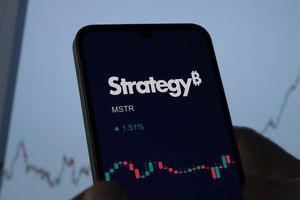
The age-old debate between Bitcoin (BTC) maximalists and gold standard proponents has reached a fever pitch, fueled by recent dramatic shifts in the cryptocurrency and precious metals markets. At the heart of this renewed contention are James C. Heckman, CEO of Roundtable, and the staunch gold advocate Peter Schiff, whose contrasting views on Bitcoin's (BTC) viability as a store of value against gold have captivated investors and analysts alike. The ongoing discussion, particularly amplified by Bitcoin's (BTC) recent record highs and subsequent sharp corrections, alongside gold's (XAU) impressive rally, underscores a fundamental divergence in investment philosophy that has significant implications for the future of global finance.
The latest chapter in this saga unfolded as Bitcoin (BTC) surged to an unprecedented $126,080 on October 6, 2025, only to experience a precipitous drop of over 16%, plunging to $105,000 before a swift rebound above $114,000. This volatile swing, which liquidated over $5 billion in leveraged positions in a single day, provided fresh ammunition for critics like Schiff. Simultaneously, gold (XAU) has been on a robust upward trajectory, surpassing $4,300 per ounce and briefly touching $4,350, cementing its status as a traditional safe haven amidst mounting global economic anxieties and geopolitical tensions. This stark divergence in immediate market behavior has reignited the core question: Which asset truly offers a more reliable hedge against uncertainty and a superior long-term store of value? The outcome of this debate will undoubtedly shape investment strategies and potentially influence broader economic paradigms as we navigate an increasingly complex financial landscape.
Market Impact and Price Action
The recent market dynamics have painted a vivid picture of the contrasting risk profiles of Bitcoin (BTC) and gold (XAU). Bitcoin's (BTC) journey from its all-time high of $126,080 on October 6, 2025, to a rapid decline below $105,000 before its swift recovery, epitomizes the digital asset's inherent volatility. This sharp correction, wiping out billions in leveraged positions, highlights the speculative nature that Peter Schiff frequently criticizes. Despite this, Bitcoin's (BTC) ability to rebound above $114,000 within minutes also showcases its robust liquidity and the strong underlying demand from a dedicated investor base, often viewing dips as buying opportunities. Trading volumes during these periods of extreme price action have been exceptionally high, indicating intense market activity and a battle between bullish and bearish sentiments. Key support levels around the $100,000-$105,000 mark proved resilient during the recent downturn, while resistance currently hovers near the $120,000-$125,000 range. This pattern of rapid ascent followed by significant, albeit often temporary, corrections has been a recurring theme in Bitcoin's (BTC) history, reminiscent of its 2021 bull run and subsequent drawdowns, each time eventually leading to new highs.
In stark contrast, gold (XAU) has demonstrated remarkable stability and consistent upward momentum. Since the beginning of 2025, gold (XAU) prices have surged by approximately 65%, with spot prices exceeding $4,300 per ounce and even touching $4,350. This sustained rally is a testament to gold's (XAU) enduring appeal as a safe-haven asset, particularly in times of global economic uncertainty, renewed banking sector concerns, and escalating geopolitical tensions. The weakening of the U.S. dollar (USD) and aggressive accumulation by central banks, diversifying away from dollar reserves, have further bolstered gold's (XAU) price action. Unlike Bitcoin's (BTC) sudden, dramatic swings, gold's (XAU) movements have been more measured, reflecting its role as a traditional hedge. Technical analysis for gold (XAU) suggests strong upward channels, with key support forming around $4,000 and analysts eyeing $4,500 as a potential next target. The consistent performance of gold (XAU) during this period of market jitters provides compelling evidence for Schiff's arguments regarding its reliability and intrinsic value, especially when juxtaposed against Bitcoin's (BTC) more turbulent ride.
The divergence in price action between Bitcoin (BTC) and gold (XAU) since early October has been particularly telling. Schiff noted that Bitcoin (BTC) had lost roughly 32% of its value relative to gold (XAU) since August, using this as a powerful indicator that Bitcoin (BTC) has "failed the test as a viable alternative to the U.S. dollar or digital gold." While Bitcoin (BTC) proponents argue that its long-term performance (averaging 54% annualized return from 2014-2024) still dwarfs gold's (XAU), the short-term volatility provides ample fodder for critics. The market's response to these two assets clearly illustrates the ongoing paradigm shift: one, a digital frontier asset with immense growth potential but high risk, and the other, a time-tested tangible asset offering stability and capital preservation.
Community and Ecosystem Response
The recent market volatility and the renewed debate between James C. Heckman and Peter Schiff have ignited fervent discussions across crypto social media platforms. On X (formerly Twitter (NYSE: TWTR)) and Reddit, sentiment is sharply divided, reflecting the deep ideological chasm between Bitcoin (BTC) maximalists and gold bugs. Bitcoin (BTC) enthusiasts, while acknowledging the recent price corrections, largely view them as transient "shakeouts" necessary for a healthy bull market. They point to Bitcoin's (BTC) historical resilience and its consistent recovery to new all-time highs as evidence of its long-term viability. Phrases like "HODL" and "buy the dip" trended, underscoring a strong belief in Bitcoin's (BTC) future potential despite short-term fluctuations.
Conversely, gold proponents, often echoing Peter Schiff's (Euro Pacific Capital) sentiments, took to social media to declare the recent Bitcoin (BTC) downturn as vindication of their warnings. They highlighted gold's (XAU) steady ascent as proof of its superior safe-haven qualities, questioning Bitcoin's (BTC) ability to truly act as "digital gold" during times of economic stress. Crypto influencers and thought leaders offered varied reactions. Many prominent Bitcoin (BTC) figures, including those aligned with James C. Heckman's Web3 initiatives, emphasized the growing institutional adoption of Bitcoin (BTC), the success of spot Bitcoin (BTC) ETFs, and the upcoming halving events as key drivers for future growth, predicting a potential peak between $180,000 and $200,000 in the current bull cycle. They argue that Bitcoin's (BTC) increasing maturity is reducing its volatility over time, making it a more stable asset.
The effects on related DeFi protocols, NFT projects, and Web3 applications have been mixed. While a significant Bitcoin (BTC) price drop often creates a ripple effect across the broader crypto ecosystem, the impact was somewhat cushioned by the underlying strength and innovation in these sectors. Many DeFi projects continue to build and attract users, leveraging Bitcoin's (BTC) network indirectly or through wrapped assets. NFT markets, while generally more susceptible to speculative sentiment, also showed signs of resilience, with established collections maintaining value. The broader crypto Twitter and Reddit sentiment, while experiencing moments of FUD (Fear, Uncertainty, Doubt) during the sharpest declines, quickly reverted to a more optimistic outlook, buoyed by the quick rebound and the conviction that Bitcoin (BTC) is on a long-term upward trajectory. The community's response underscores a maturing ecosystem that, while still reactive to price action, possesses a strong foundational belief in the transformative power of decentralized technologies.
What's Next for Crypto
The ongoing debate between James C. Heckman and Peter Schiff, juxtaposed against recent market volatility, sets the stage for critical short-term and long-term implications for the crypto market. In the short term, Bitcoin (BTC) is likely to remain highly sensitive to macroeconomic indicators, geopolitical developments, and regulatory news. Its recent volatility underscores that while institutional adoption is growing, Bitcoin (BTC) is not yet fully decoupled from broader risk-on/risk-off sentiment. Investors should anticipate continued price discovery and potential further corrections, especially as the market digests the implications of rising interest rates, U.S.-China trade tensions, and global banking sector stability. For gold (XAU), the short-term outlook remains strong, with analysts predicting continued upward momentum towards $4,500 per ounce, particularly if global uncertainties persist and central banks continue their gold accumulation spree.
Looking further ahead, the long-term implications for the crypto market are profound. The current environment is accelerating the maturation of Bitcoin (BTC) as an asset class. The approval of spot Bitcoin (BTC) ETFs and the upcoming halving events are powerful catalysts expected to drive new waves of institutional and retail demand, potentially pushing Bitcoin (BTC) into the $180,000-$200,000 range in its current bull cycle. This increasing institutionalization, implicitly supported by figures like Heckman through their Web3 ventures, suggests a future where Bitcoin (BTC) plays a more integrated role in traditional finance. However, it will also face increased scrutiny and competition from traditional safe havens like gold (XAU).
Strategic considerations for crypto projects and investors revolve around diversification and risk management. Projects need to continue focusing on utility, security, and scalability to build lasting value beyond speculative fervor. Investors, on the other hand, might consider a balanced approach, potentially allocating to both Bitcoin (BTC) for its growth potential and gold (XAU) for its proven stability. Possible scenarios include a continued "de-bitcoinization" phase as predicted by Schiff if Bitcoin (BTC) fails to demonstrate consistent safe-haven properties, or a "digital gold" narrative solidifying if Bitcoin (BTC) continues its long-term upward trend and its volatility declines further, as some analysts suggest. The likelihood of the latter increases with sustained institutional adoption and clearer regulatory frameworks. The debate itself serves as a crucial barometer of how traditional and new-age finance perceive value in an evolving global economy.
Bottom Line
The intense debate between James C. Heckman and Peter Schiff, amplified by the recent market volatility, underscores a fundamental question facing investors today: what constitutes a reliable store of value in the 21st century? For crypto investors and enthusiasts, the key takeaway is that Bitcoin (BTC), while demonstrating unparalleled long-term growth and increasing institutional acceptance, still carries significant short-term volatility. This necessitates a robust understanding of its risk profile and a long-term investment horizon. Gold (XAU), conversely, has reaffirmed its role as a stable, tangible hedge against economic and geopolitical uncertainties, offering a contrasting, more conservative investment thesis.
The long-term significance of this ongoing discussion lies in its potential to redefine global financial paradigms. If Bitcoin (BTC) continues its trajectory of maturation, with declining volatility and growing utility within the Web3 ecosystem as championed by figures like Heckman, it could cement its position as a legitimate "digital gold." However, if global economic anxieties persist and Bitcoin (BTC) fails to consistently act as a safe haven, Peter Schiff's arguments for gold's (XAU) enduring intrinsic value will continue to resonate. The current market conditions highlight that while Bitcoin (BTC) has been the best-performing asset over the past decade, averaging a 54% annualized return, its journey to mainstream acceptance as a stable store of value is still in progress.
For crypto adoption, this debate is crucial. Increased scrutiny and comparison to traditional assets like gold (XAU) force Bitcoin (BTC) and the broader crypto ecosystem to prove their value proposition beyond speculative gains. Important metrics to monitor include Bitcoin's (BTC) volatility index relative to other asset classes, institutional inflow into spot Bitcoin (BTC) ETFs, central bank gold (XAU) accumulation rates, and global macroeconomic indicators. Key events to watch are upcoming Bitcoin (BTC) halving cycles, which historically precede bull runs, and any significant regulatory shifts that could either bolster or hinder crypto adoption. Ultimately, investors must weigh Bitcoin's (BTC) disruptive potential and historical returns against gold's (XAU) proven track record and stability, making informed decisions based on their individual risk tolerance and investment objectives.
This article is for informational purposes only and does not constitute financial or investment advice. Cryptocurrency investments carry significant risk.





